Combination Resume Guide [w/ Templates & Examples]

Are you in the middle of a career change?
Or maybe you’re a senior professional with a diverse set of skills?
Whichever the case may be, the combination resume might be the right one for you!
This hybrid resume allows you to highlight both your work experience AND skills in a single resume, making your professional background shine!
So, want to learn more?
- What a combination resume is & when to use it
- How to create a hybrid resume that really stands out
- How to write must-have sections for any combination resume
Let’s get started!

What’s a Combination Resume
So, what is a combination resume exactly and what does it combine?
Essentially, a combination resume , aka a hybrid resume , combines 2 traditional resume formats .
It’s a mix of the reverse-chronological resume and the functional resume format.
As in, it places equal emphasis both on your skills and work experience.
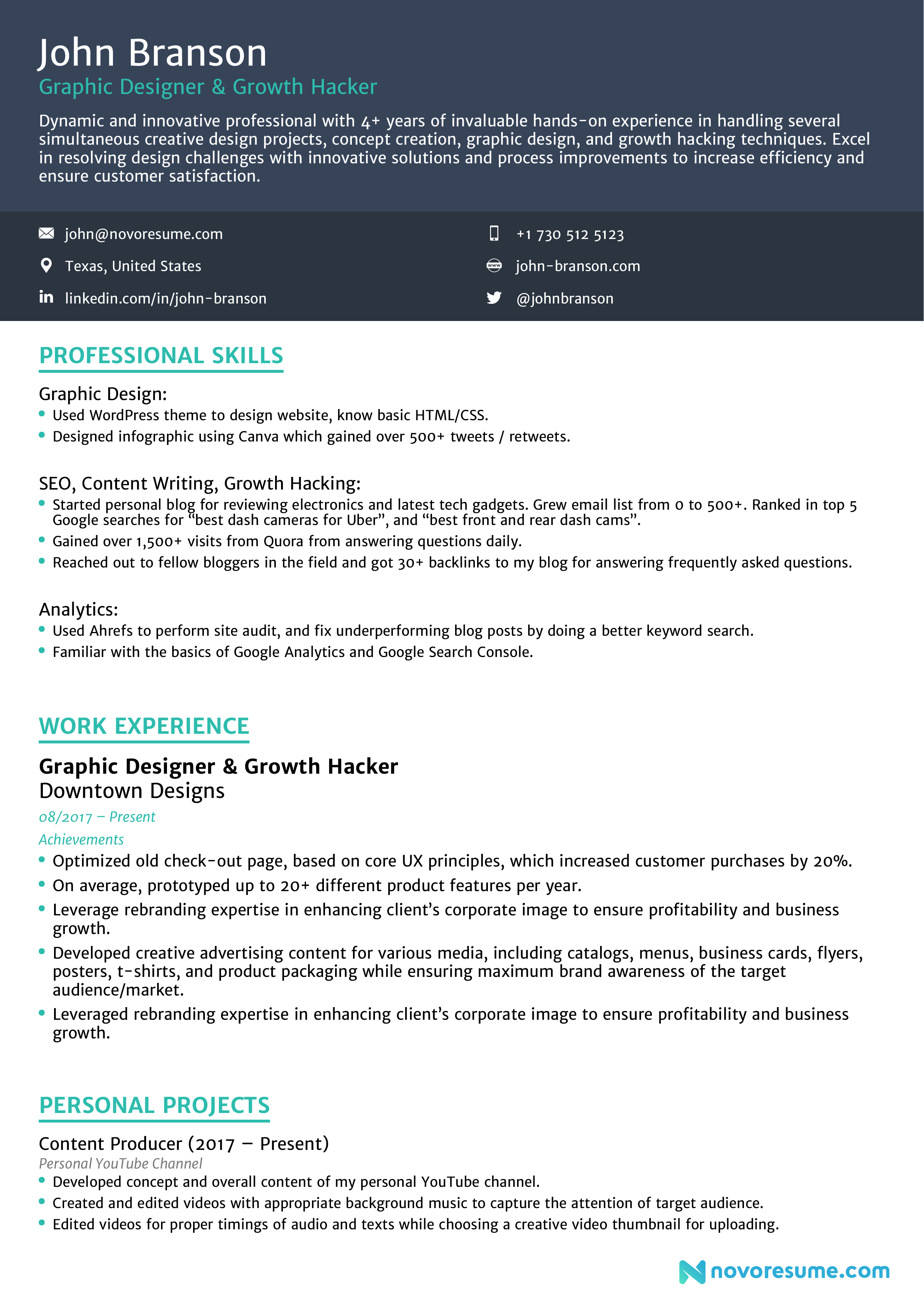
The format offers 2 main advantages:
- It allows you to present a quick overview of your actual employment history and the areas that are transferable.
- While at the same time, showing the HR manager your top skills and qualifications.
Keep in mind, though, unless you’re in a very specific situation, the combination resume might not be the right resume format for you. What do we mean?
Read on to find out.
When to Use a Combination Resume
The combination resume is pretty rare.
Most job-seekers worldwide tend to use a reverse-chronological format (and for a good reason). It’s pretty much the standard: HR managers are used to it, it’s straightforward and easy to make.
The combination resume format is very situational. You shouldn’t use it unless you:
- Are going through a career change.
- Have some employment gaps in your work history.
- Are a senior-level candidate, with a diverse range of skills and experiences.
In case you fit the bill for one of these 3 cases, though, here’s how to create a combination resume.
What to Put on a Combination Resume
When creating a combination resume, a proper layout is your best friend.
Typically, you’ll want to cover the following resume sections :
- Contact Information
- Resume Summary
- Work Experience or Areas of Strengths
- Skills Summary
- Additional Skills
Now, we’ll walk you through each of these sections, and teach you how to write them.
Starting with -
Add Contact Information the Right Way
Let’s start with the basics.
If the HR manager is interested in interviewing you, they’ll want to know how to reach you.
In the contact information section you include:
- First name, last name.
- Phone number - Make sure you include your country code if you’re applying outside your country.
- Email address - Your email should be professional. Ideally, something like [FirstName][LastName]@gmail.com
- Location - Are you located in the area? Open to relocation? Or maybe you’re looking for a relocation sponsor? Make sure it’s clear.
- Title - Your professional title goes here. Either your current job or the one you’re applying for word-for-word. If you’re switching careers, you could also do something like “Aspiring [Desired Job Title]”
Once done, make sure you double-check everything, slowly and carefully, for any typos.
We’d recommend reading everything out loud just in case. You’re not going to go far if the recruiter can’t get in touch with you because of a typo in your email.
Got the basics down? Good!
Now, let’s move onto the resume summary .
Grab the Recruiter’s Attention With a Resume Summary

A resume summary is a 2 - 5 sentence summary of your professional background.
You should look at the resume summary as an introduction to your resume.
It’s the first thing the recruiter sees on your resume, and if you fail to catch their attention, they’re not going to read the rest of it.
So, how do you write a good resume summary?
You mention things like:
- Career highlights
- Qualifications
- Top achievements
- Relevant skills
Here’s an example to better understand what that might look like.
- “IT project manager with a proven track record of working with agile and waterfall methodologies. Managed teams of 5+ people on software development projects over the last 4 years. Decent understanding of JavaScript, React, and Python.”
PS - Need more inspiration for writing a strong resume summary? Check out our how-to guide with 40+ resume summary examples .
Use Your Work Experience to Show Off Relevant Skills
The next section in your combination resume is the work experience.
The work experience section is where you get to really sell yourself and brag about your past achievements.
List out your work history in a reverse-chronological order (starting from the most recent and ending with the oldest), and mention the standard things like:
- Job title and position
- Company name, location - If the company isn’t famous, you can describe what they do in 1-2 sentences. And you should always mention the location too.
- Period of employment - The standard format is mm/yyyy - mm/yyyy.
- Achievements or responsibilities - With achievements, you should list any specific changes you made happen (think in terms of numbers and data). Though, if that’s not possible because of the nature of the job (e.g. cashier), you can just stick to responsibilities.
Sounds simple enough, right?
A couple of other things you should keep in mind when writing a work experience entry:
- When possible, focus on achievements instead of responsibilities.
- Back up your experiences with numbers and data.
- Tailor your experience to the job you’re applying for.
Now, here’s what a work experience entry looks like in practice:
Web Developer
Company X, Denmark, Copenhagen, 05/2018 - Present
- Full-stack developer, responsible for web applications and creative cloud engineering. Led a team of 5+ junior developers, using different methodologies.
- Optimized old check-out page, based on core UX principles, which increased customer purchases by 20%.
- On average, prototyped up to 20+ different product features per year.
Here’s what’s done right:
- Information is relevant, and straight to the point.
- It’s backed up by data and numbers.
- It lists achievements over daily responsibilities.
Now, compare that to -
Company X, Denmark, Copenhagen, 05/2016 - 07/2019
- Collaborated with project managers and provided updates.
- Designed website and mobile apps, while providing exceptional user experience.
- Worked with other developers in a team.
That’s extremely vague, right?
It doesn’t really say anything, or HOW the person actually did their job.
Now, imagine you’re the HR manager and you get to pick between these 2 candidates.
Which one would you pick?
- Going through a career change? You might want to use your work experience section to highlight your transferable skills.
- This way, you’re showing how your seemingly irrelevant work experience gave you the skills you need to do the new job right.
Show You’re the Right Person With the Skills Summary Section
The skills summary section is what differentiates the combination resume from the reverse-chronological one.
This is where you show your know-how for the job and that you have the right skills for it.
This section is especially useful for career changers, as it allows you to focus more on your skills (as opposed to work experience).
So, how do you write a skills summary section?
You start by listing all the required skills for the job you’re applying for.
For example:
- SEO, Content Writing, Growth Hacking
- Graphic Design
Then, underneath each skill listing, you describe how you’ve used this skill in the past.
Combination Resume Skills Summary Example
- Started personal blog for reviewing electronics and latest tech gadgets. Grew email list from 0 to 500+. Ranked in top 5 Google searches for “best dash cameras for Uber”, and “best front and rear dash cams”.
- Gained over 1,500+ visits from Quora from answering questions daily.
- Reached out to fellow bloggers in the field and got 30+ backlinks to my blog for answering frequently asked questions.
- Used WordPress theme to design website, know basic HTML/CSS.
- Designed infographic using Adobe Illustrator which gained over 500+ tweets / retweets.
- Used Ahrefs to perform site audit, and fix underperforming blog posts by doing a better keyword search.
- Familiar with the basics of Google Analytics and Google Search Console.
Not bad, right?
But what if you’re not switching careers, do you still include the skills summary section?
In that case, you’re using a skills summary section to show your vast range of skills and know-how (that your experience section can’t cover).
If you’re an experienced candidate, your main skills probably don’t stop there.
And that brings us to the next section of your combination resume.
Additional Skills for a Combination Resume

Remember how in the previous section (skills summary), we mentioned the must-have skills?
Well, this is where you list everything you left out.
Now, all you have to do is scan a job ad you want to apply for, look for all the essential skills that you didn’t mention in the skills summary section, and mention them in this section.
Let’s take a look at an example...
Combination Resume Skills Example
Let’s assume that the job is looking for a designer who has:
- Proficiency in UX software (Sketch, InVision, Photoshop XD, etc.).
- Basic understanding of HTML, CSS.
- Strong problem-solving, project management and organizational skills.
- Good communication skills and is a team player.
Now, all you’d have to do is mention those requirements in your skills section, like so:
- HTML and CSS.
- UX / UI software (Sketch, InVision, Photoshop XD, Figma).
- Verbal and written communication.
- Teamwork and time management.
Wondering what other skills are essential for your job? Check out our full guide of 150+ must-have skills for any resume .
Now that you know how to get the skill section right, let’s move on to the next section - education .
Write an Education Section That Stands Out
Your education section comes last on a combination resume, but luckily, it’s fairly straightforward.
The section is pretty much a requirement for any resume.
Here’s what you include in your education section:
- Type of degree - e.g. MSc in Economics and Business Administration
- Educational institution name - The University of Chicago
- Years attended - 09/2017 - 06/2019
- Program location (optional) - Chicago, Illinois
- GPA (optional, only if noteworthy) - 3.87
- Relevant courses (optional) - Project Management Principles and Practices
- Exchange program (or any other noteworthy achievements) - Exchange program in Washington, D.C.
Here’s what the full listing might look like for a combination resume :

Now, what if your degree isn’t relevant to the job you’re applying for, as it might be if you’re switching careers?
Do you still list it?
As long as you have an actual degree, it still says a lot about your passion and commitment to education.
In some cases, you can even show off some transferable skills with your degree.
Let’s take a look at another example and say you’re applying for a graphic design job , with a B.A. in Communication :
B.A. in Communications
University X, 10/2013 - 06/2017
- Excelled in visual communication and digital media classes.
- Designed posters for university events and social media content.
Key Takeaways
To recap, a combination resume is a type of resume format that places equal emphasis on your skills and work experience.
To make sure your hybrid resume is exceptional, here’s what you should keep in mind:
- Make sure you cover all the necessary sections for a combo resume: contact information , resume summary , skills summary , additional skills , and education .
- When listing your qualifications, focus on only what’s relevant .
- Finally, end with your education . Even if your degree isn't relevant to the job, you should still include it to show your passion for learning.
Done with your resume and looking for extra career advice? Be sure to check out our career blog for more actionable advice and insights.
Discover More Resume Templates
- Chronological Resume Templates
- Minimalistic Resume Templates
- Creative Resume Templates
- One Page Resume Templates
- 2 Page Resume Templates
- Word Resume Templates
- Google Docs Resume Templates
- High School Resume Templates
Recommended reading:
- 43+ Resume Tips and Tricks to Land Your Next Job in 2024
- 35+ Common Interview Questions and Answers [Complete List]
- What Are The Most Common Mistakes In A Resume In 2024? [Examples]

To provide a safer experience, the best content and great communication, we use cookies. Learn how we use them for non-authenticated users.
Combination Resumes: How (and When) to Use Them + Examples

3 key takeaways
- A clear understanding of this resume format and how it differs from other resume types
- What scenarios a combination resume is most beneficial in (and how it can improve your job application)
- Tips and guidance for creating your combination resume with Teal's AI Resume Builder
When you're job searching, you need to present your skills and experiences in a way that stands out to potential employers.
For many, especially those with employment gaps or diverse professional backgrounds, the solution is learning how to use a combination resume.
This unique resume format blends the best of chronological and functional resumes, offering a versatile approach to showcasing your career journey.
Combination resumes are especially useful for those looking to transition between industries, re-enter the workforce, or highlight a broad skill set. And with the right combination resume templates or examples, you can effectively bridge the gap between your past experiences and future ambitions.
What is a combination resume?
A combination resume incorporates elements of both functional resumes and reverse-chronological resumes . It allows you to showcase your relevant skills and your work history in a balanced way.
This format typically starts with a clear professional summary, then highlights your hard skills, followed by a reverse-chronological listing of your work experience.
Combination resumes are particularly useful if you have diverse skills or varied work experiences and want to showcase these elements effectively. It's ideal for those making a career change, re-entering the workforce, or who have gaps in their employment history.
By emphasizing your skills upfront, you can draw attention to what you can do rather than when you did it. For job seekers looking to emphasize both their skills and experience, the combination resume template is an excellent choice.
How does a combination resume compare with other formats
While the chronological resume focuses primarily on work history and the functional resume emphasizes skills, the combination resume strikes a balance between the two. This hybrid resume approach offers the flexibility to highlight the aspects of your professional profile that are most relevant to the job title you're applying for.
That’s what makes it a strong option compared to other resume formats .
It's important to remember that a combination resume still maintains a chronological order in its work history section. It's not just about listing skills but also about demonstrating how these skills have been applied throughout your career.
For recent graduates, this format can highlight educational experiences, while for those pivoting careers, it can focus on relevant projects or volunteer work that aligns with the new role.
How to format a combination resume
A combination resume, as its name implies, combines elements of both chronological and functional resumes. This format allows you to highlight your most relevant skills and experiences while providing a clear timeline of your work history.
Key sections of a combination resume
- Header : This includes your name, contact information, and, optionally, links to your professional online presence (like LinkedIn).
- Professional Summary : A brief, impactful section encapsulating your career highlights and key skills.
- "Skills" section : A list or bullet points showcasing your most relevant skills. Remember, this section should be tailored to the specific job you're applying for.
- Professional experience : Focus on accomplishments, impact, and how you used your skills for each role rather than just duties. Keep in mind every job should be relevant to the role you're applying for.
- Education : Your educational background, often listed in reverse chronological order.
- Additional sections : Depending on your experience, this can include certifications, awards, volunteer work, or personal projects.
The beauty of a combination resume lies in its flexibility.
Typically, after the header and professional summary, the skills summary comes next, immediately showcasing your most relevant abilities. The professional experience follows, providing context and proof of your skills.
Education and additional sections come at the end, supporting the overall narrative of your resume.
That said, there’s a slight difference in format depending on the context.
Combination resumes for recent graduates
The combination resume format particularly benefits recent graduates lacking extensive work experience.
Instead, they can substitute their educational experience, including relevant projects and courses, in a prominent position.
This approach allows them to highlight their potential and the skills they've acquired through their education, which are relevant to the job they're applying for. The format would still maintain a reverse chronological order, ensuring it is easy to read and professionally structured.
Combination resumes for a career pivot
For individuals making a career pivot, the combination resume format provided above allows them to emphasize transferable skills and relevant projects or volunteer work. These elements can replace or complement the traditional work experience section.
This approach helps in showcasing how their skills and experiences, even from different fields, are applicable to the new role they are targeting. Again, maintaining a chronological format ensures clarity and structure, which is essential for any professional resume.
In both cases—for recent graduates and career changers—a combination resume serves its purpose well, balancing the skills and experiences relevant to the new role while maintaining a clear, chronological format.
How to write a combination resume
Here’s a detailed guide to writing each section of your combination resume.
As the first impression, your header should clearly display your name, contact information, and any professional links like LinkedIn.
Make sure it’s easily visible at the top of your resume. A professional-looking header sets the tone for the rest of the document.

2. Professional summary
This is where you craft your elevator pitch. The goal is to summarize your career journey and highlight skills that transfer well to the new role.
Make it engaging, concise, and focused on why you’re a great fit for this career shift.
Here’s an example of a professional summary for Sarah, a junior marketer looking to enter a mid-level role:
Dynamic junior marketer with 3+ years of experience specializing in digital campaigns, SEO, and social media strategies. Proven ability to boost web traffic and conversion rates through innovative and data-driven approaches. Seeking to leverage creative problem-solving and market analysis skills in a challenging mid-level marketing role.
3. Skills summary
List hard skills like tools or programs that are directly relevant to your new career.
In a combination resume, this part immediately showcases your most relevant capabilities and will ideally be a balance of hard and soft skills relevant to the job description.
4. Professional experience
Start with your most relevant job roles, even if they aren't in the new career field. Focus on achievements and demonstrate how you used transferable skills to have an impact.
If you’re feeling stuck on how to write your professional experiences, use the Problem-Action-Result (PAR) method to articulate your past contributions.
You can also rely on Teal’s built-in AI to help you draft your resume’s content:
Just be sure to manually check that the information is accurate when you review your resume.
5. Education
Include all relevant degrees, certifications, and coursework.
If you’re a recent graduate or have less professional experience in the new field, this section would be used in place of “Professional Experience.” It can also be expanded to showcase academic achievements, projects, or relevant courses that align with your new career path.
6. Additional sections
This is your space to include anything else that strengthens your application. Consider adding sections for volunteer work, projects, languages, or other certifications. Tailor this part of the resume to showcase experiences and achievements that further demonstrate your suitability for the career change.
Remember, the key to a successful combination resume for a career change lies in how well you customize these sections to showcase your transition into a new career effectively.
Writing a combination resume with Teal
If you’re just getting started, crafting the perfect combination resume can feel overwhelming, especially when balancing so many elements of your professional journey.
But Teal’s Drag-and-Drop Editor transforms this challenge into a seamless and intuitive process. You can effortlessly rearrange sections to suit your unique story, ensuring that your skills, experience, and accomplishments are presented in the most impactful way.
Whether you're a career changer, a seasoned professional with diverse experiences, or someone bridging employment gaps, Teal allows you to create a resume that highlights your strongest assets. Then, you can modify your resume layout to your liking.
Plus, Teal recognizes the importance of a resume that can be scanned by applicant tracking systems (ATS).
Teal helps you craft resumes and cover letters that incorporate keywords directly from job descriptions. You can write them from scratch, use the Achievement Assistant, or generate them with the help of Teal’s built-in AI.
From there, you can polish everything to ensure your combination resume is as strong as it is genuine.
Tips for writing compelling resume content
An impactful combination resume not only showcases your qualifications but also tells a compelling story of your professional journey. With the right approach, your resume can capture the essence of your career and present you as an ideal candidate for the job.
Here are some essential tips to help you create content that stands out, aligns with the job requirements, and effectively communicates your value.
1. Start with action verbs: Begin each bullet point in your experience section with dynamic action verbs.
For instance, instead of saying, "Responsible for managing a team," say, "Led a team of 10 professionals to surpass quarterly sales targets by 13%."
2. Quantify achievements: Whenever possible, include concrete numbers and metrics to quantify the work you’ve done.
For example, rather than saying "Improved sales," specify with, "Increased sales by 25% over six months through strategic marketing campaigns."
3. Tailor content to the job: Align your resume's content with the job description by incorporating relevant keywords.
If the job listing emphasizes "project management" and "team leadership," ensure these terms are reflected in your resume, like "Spearheaded a project team to deliver on-time solutions in a fast-paced tech environment."
4. Write clearly and concisely: Avoid industry jargon and complex sentences.
For example, instead of saying, "Utilized cutting-edge methodologies to engender an increase in consumer engagement," you could say, "Applied innovative strategies to boost customer engagement by 30%."
At the end of the day, the key to an effective combination resume is to present a clear, engaging narrative of your career that aligns with the job you're applying for.
Writing a combination resume for career change
Changing careers can be challenging. You’ve already climbed the ladder in one field, and now you’re starting all over at the bottom wrung.
Plus, you need to quickly and concisely explain the transition to hiring managers so they don’t assume you’re a flight risk.
Here are a few tips for writing a combination resume specifically for a career change.
1. Highlight transferable skills
When transitioning to a new career field, it's essential to showcase skills from your previous roles that are relevant to your new path. Focus on transferable skills that can be applied in various contexts.
For instance, if you’re moving from a teaching role to a corporate training position, skills like public speaking, curriculum development, and audience engagement are highly relevant.
List these skills in a dedicated section and use specific examples in your work history to demonstrate how you've applied them effectively.
2. Emphasize relevant experience
Your past roles may have more in common with your new field than you think. Scrutinize your work history to identify projects, tasks, or responsibilities that have a direct correlation with the role you’re targeting.
For each job you list, focus on aspects that align with your new career. For example, if you’re moving into project management, highlight your experience coordinating tasks, managing teams, or overseeing project timelines.
Even roles in different industries can provide relevant experience, such as managing a project or leading a team.
3. Use the professional summary wisely
Your professional summary is the first thing employers will read, so it's your chance to make a strong impression. This is where you can express your career change intention and why you are a suitable candidate.
Write a compelling summary that combines your passion for the new field with your proven skills.
For example, “Passionate about transitioning into digital marketing, leveraging extensive experience in content creation and audience engagement gained from a successful journalism career.”
4. Include your education and continued learning efforts
Highlighting your education and any ongoing learning efforts is crucial, especially if they are relevant to your new career path. This shows employers your commitment to the field.
List any recent courses, workshops, or certifications at the top of your education section. For instance, if you’re moving into IT, including certifications like CompTIA or Cisco CCNA can be highly beneficial.
5. Include projects or volunteer work
Non-professional experiences can be just as valuable as paid roles, particularly when they're relevant to the field you're entering.
Include any freelance projects, internships, or volunteer work that’s related to your new career.
For example, if you’re aiming for a career in graphic design, include freelance design projects or volunteer work where you created promotional materials for events. Detail these experiences just like you would a job, focusing on what you achieved and learned.
Using Teal’s AI Resume Builder
Teal’s AI Resume Builder simplifies the process of writing a combination resume. It provides guidance and suggestions for each section, ensuring your content is optimized and impactful. With Teal, you can:
- Use AI-driven suggestions to enhance your professional summary and skills summary.
- Tailor your resume to each job application, with Teal highlighting the skills and experiences most relevant to the role.
- Format your resume with ease, thanks to Teal’s user-friendly interface.
Writing a combination resume with Teal is not only easier but also more effective.
Combination resume examples
A good combination resume example can be a great reference to understand how to create your own resume more efficiently. Here are a few examples you can learn from.
Frontend Developer
This combination resume example is perfect for a junior-level employee looking to transition into a new role. The relevant skills are placed after the professional summary, followed by her work experience.

However, because her professional experience is limited, this example provides more information about internships and volunteer projects.
Marketing Manager
Here we have Max, a marketing manager with a more extensive work history. The skills section is still prioritized, but his working history takes on a reverse chronological format.

Crafting your combination resume
Navigating the creation of a combination resume isn't just about assembling parts of your professional history; it's about strategically highlighting your diverse skills and experiences to capture the heart of your career journey.
A combination resume is your chance to paint a compelling picture of your professional landscape—from your multifaceted skills to the chronological narrative of your work history. It elegantly bridges the gap between showcasing a rich skill set and a robust employment history.
Whether you're navigating employment gaps, embarking on a career change, or a recent graduate, this format adapts to your unique story, ensuring that your application resonates with potential employers.
Teal’s Drag-and-Drop Editor simplifies this process, allowing you to effortlessly blend sections, customize layouts, and build the combination resume that best represents you.
I you're ready to elevate your job application, bring your unique professional story to life with Teal. Sign up today , explore the power of the combination resume with Teal’s innovative tools, and step into your next career chapter with confidence.
Frequently Asked Questions
What is the primary advantage of using a combination resume over other resume formats, how can i decide if a combination resume is the right choice for my job application, can a combination resume be used for entry-level positions, or is it only suitable for experienced professionals.

Nathan Thompson
Related articles.
.jpg)
Zety Reviews: Ratings and Customer Feedback

Jobscan Reviews: Ratings & User Feedback

LinkedIn Skills: How to Choose, Add & Delete Skills On LinkedIn [+ Examples]
.jpeg)
How to Add Projects to LinkedIn: A Step-By-Step Guide (2024)
We help you find the career dream..
Combination Resume Writing Guide
Create a resume using the best of both worlds: skills and experience

Certified Professional Resume Writer
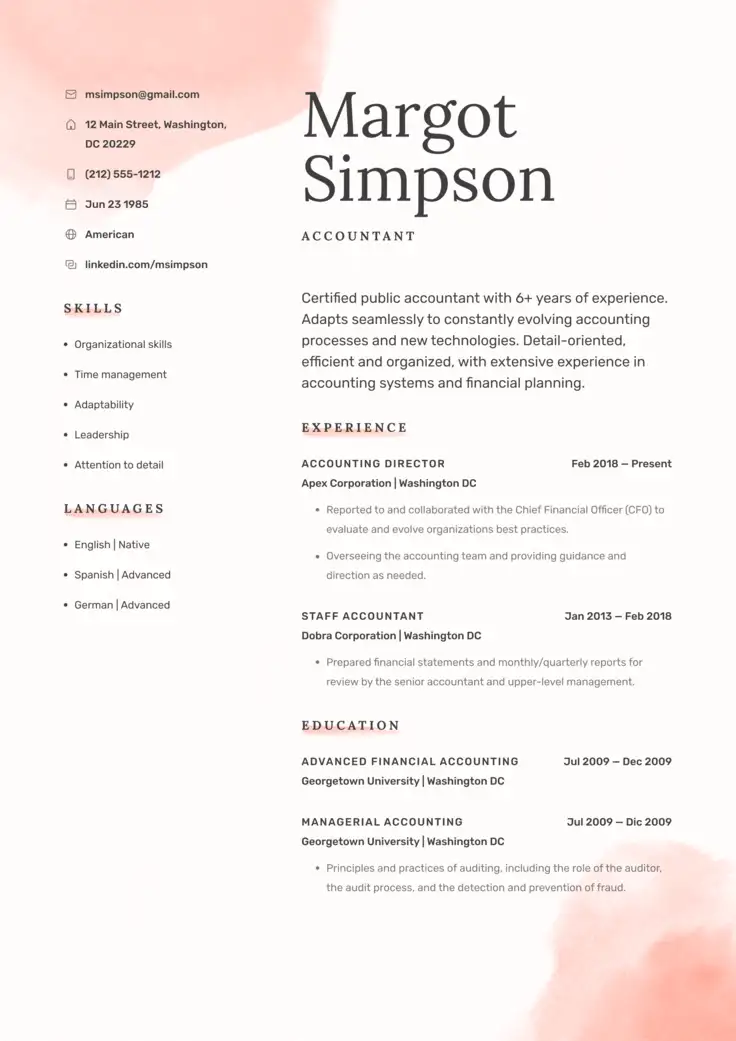
If you find that the chronological resume format is not working for you, it could be for any number of reasons and you may be better suited to a combination resume layout to present your profile to potential employers.
What is the combination resume , you ask? Sometimes referred to as the hybrid resume or targeted resume , the combination resume employs information from all areas of a candidate’s personal and professional profile to create a well-rounded, inclusive and original resume .
A more in-depth combination resume definition follows to help you understand how to make a resume using this format, how to structure a resume and tailor it to suit your needs and especially to fit the position that you’re applying to.
For more information on what to include in a combination resume, try using resume samples or a resume builder to help you create a resume that will stand out in the job application process to help you earn the interview you’ve been waiting for.
What is a Combination Resume?
The Combination Resume is pretty much exactly what it says on the tin! A resume combined of the two standard resume formats : Chronological and Functional. The best of both worlds.
But what does that really mean? For example, what does a Combination Resume look like?
The emphasis of a combination resume is divided between the skills and abilities of the candidate and the work experience they can bring to the role.
This means that the combination resume format includes a first half dedicated to the skills and qualifications of the candidate and a second half with a recent work history section detailing the responsibilities and achievements from those roles.
The combination resume is an excellent choice for professional jobseekers who are looking to change careers, industries or positions or for candidates who have a specific, well-developed skill set that they wish to present along with their career trajectory.
Similar to the professional resume style, this can be beneficial for executives or applicants who are experts in their fields .
Also, if the position offered requires a lot of technical skills, a combination resume format is ideal to underline the abilities of the candidate and give evidence as to how the applicant has obtained the skills in question, applied them and the results achieved through their personal implementation.
The Combination Resume Layout
Find out how to create a combination resume using a resume template or from scratch or with a resume maker with the following information about the combination resume layout.
As the combination resume employs a mix of the two more classic styles of resumes , it’s very important that you carefully consider the combination resume format which generally begins with a summary of the qualifications , includes an education and skills section and also a work history list, only citing the most relevant positions but also detailing achievements and responsibilities from those roles.
The main parts of a Combination Resume include the following in this order:
- Contact details
- Qualifications summary with descriptions
- General skills section
- Work experience with descriptions
Each of these areas is considered vital to a combination resume format. Learning how to write a qualifications summary for a combination resume is not easy but with the tips below, your resume should come together nicely to represent your professional profile as a whole incorporating as many suitable aspects as possible.
- The combination resume structure includes an introduction to the resume , also known as the ‘Qualifications Summary’ or sometimes ‘Professional Profile,’ similar to the functional resume format , which describes 4-5 bullet-pointed abilities or achievements that are key to the role or character of the candidate. These details should have quantifiable results where possible.
- It’s also essential to add examples of how you specifically have used your skills to improve or increase productivity or another aspect of the company. You should ensure that this information is relevant to the position and unique to your abilities as well as quantifiable (lack of quantifiable results is a resume dealbreaker for 35% of employers, according to CareerBuilder ).
- The next element to include in your combination resume layout is the more general list of skills that apply both to you and to the vacancy. Followed by the longer and more in-depth work experience section which should consist of 2-3 previous positions held in a sector, role or industry similar to if not the same as the current vacancy.
- Similar to the chronological resume layout, the combination resume structure includes a paragraph or bullet points under each job title to explain the responsibilities and objectives accomplished in each.
- Finally, the combination resume format includes the education section at the end with a brief list of courses, diplomas and degrees awarded to the candidate.
To simplify the need to learn how to make a resume with a combination layout without resume help, you could also try out an online resume builder or download a resume example.
Tips for Writing your Combination Resume
- To understand how to write a combination resume, you will need to begin by taking a step back and looking at your professional trajectory, achievements, skills and even your personal hobbies . This way you will gain an idea of how to fit your profile within the combination resume structure.
- After your review you’ll need to cut out all the irrelevant information and make a list of what achievements, skills, job placements and other information to include in the combination resume that will stand out to a potential employer for the specific vacancy that interests you.
- With these details you can begin to fill out your combination resume template or complete your own using the general resume format described above or use this information to make your resume with an online resume builder .
- Both the combination resume qualifications summary and the work experience sections should include a short explanation of quantifiable examples of how you as an individual have implemented your abilities or proven to be an asset in a previous role.
- You can mention awards, scholarships, internships, publications , projects, courses, conferences, etc. in your qualifications summary as long as it is apt for the position and demonstrates your strengths. Make sure to present any additional information in a convincing manner by using action words and keywords taken from the job description.
Come up with the perfect way to express your skills and experience on your resume with AI-generated suggestions in our resume builder.
The combination resume layout is ideal for candidates looking to make a change in their career , who already have work experience but wish to make use of their current knowledge and skills in a new role, industry or sector.
The idea of the combination resume for career changers is that they’re able to identify their transferable skills and organize them in a suitable manner to provide the potential employer with a guide to the type of worker they are so they can assess how they will perform in the new role.
However, the combination resume format relies heavily on being able to provide a brief work history, skills and different examples of hands-on experience therefore it is not the preferred resume for students or entry-level candidates as they require a heavier focus on education, awards and often more social skills than technical abilities.
Combination Resume Templates
Resume templates with a combination resume format are a practical tool for jobseekers who wish to create a combination resume but do not know where to start.
Using a combination resume example allows suitable candidates to create a winning resume from the template, which emphasizes both the skills and work experience. Saving both time and effort, jobseekers can complete the resume template with their personalized information to build a combination resume which will earn them their next interview.
A combination resume sample gives examples of what to put in each section which the candidate can use as a guide to ensure they make the most of the practical combination resume format.
Even if you choose to use a combination resume template , it does not mean that you must stick to a rigid structure.
Candidates are encouraged to customize their resume by removing and adding resume sections which are more relevant to their professional profile or the vacancy on offer.
ResumeCoach also advises using an online resume maker for extra help building your ideal resume . An online resume creator offers a step-by-step guide to making a resume which gives tips and examples to follow to ensure your resume is optimized regarding formatting and information.

Struggling with Resume Writing?
Ease the process with our templates

The Ultimate Guide to the Combination Resume Format: Balancing Skills and Experience
Table of contents, introduction.
Combination resume will help you write better resumes. In the world of resume writing, the combination resume format strikes a perfect balance between showcasing your skills and highlighting your work experience. Whether you’re a seasoned professional with a rich work history or a career changer looking to emphasize transferable skills, the combination resume offers the best of both worlds. In this blog, we’ll explore what a combination resume is, why it’s effective, and provide you with examples to help you craft a winning resume that captures the attention of employers.
Understanding the Combination Resume: A combination resume, also known as a hybrid resume, integrates elements of both the chronological and functional formats. It showcases your skills upfront and follows with a detailed presentation of your work experience. This format is ideal for candidates who want to highlight their qualifications while still providing a clear work history.
Advantages of a Combination Resume
- The combination format showcases your skills while still providing employers with a chronological view of your work history.
- It allows you to place emphasis on your key skills, ensuring they’re not overlooked by hiring managers.
- Combination resumes are perfect for career changers, as they enable you to highlight relevant skills when your work history isn’t directly aligned with the new role.
- If you have a consistent work history and want to emphasize skills gained along the way, this format can effectively showcase both.
Combination Resume Examples
[Your Name] [Contact Information: Phone Number | Email Address | LinkedIn Profile]
Accomplished project manager with 8+ years of experience leading cross-functional teams to successful project completion. Adept in strategic planning, risk management, and fostering collaboration for achieving project goals.
- Project Management
- Team Leadership
- Budgeting and Resource Allocation
- Stakeholder Engagement
- Agile Methodology
- Conflict Resolution
Project Manager | XYZ Corporation | City, State | January 2016 – Present
- Led a team of 10 to deliver 15+ successful projects, exceeding client expectations and enhancing company reputation.
- Collaborated with stakeholders to define project scope, objectives, and key deliverables.
- Implemented Agile methodologies, resulting in a 20% improvement in project delivery efficiency.
Business Analyst | ABC Consulting | City, State | June 2012 – December 2015
- Analyzed client requirements and translated them into actionable project plans.
- Conducted market research and data analysis to inform strategic decision-making.
- Assisted in developing innovative solutions that increased operational efficiency.
Bachelor of Science in Business Administration | University Name | Graduation Year
Dynamic marketing professional with a knack for crafting compelling content and devising innovative campaigns. Skilled in brand strategy, digital marketing, and creative problem-solving to drive engagement and brand awareness.
- Content Creation and Copywriting
- Social Media Marketing
- Brand Development
- Market Research
- Graphic Design (Adobe Creative Suite)
- Analytics and Reporting
Marketing Specialist | ABC Company | City, State | March 2018 – Present
- Created engaging content for online platforms, resulting in a 30% increase in website traffic.
- Managed social media accounts, growing follower engagement by 40% through strategic campaigns.
- Collaborated with design team to develop visually appealing marketing materials.
Digital Marketing Intern | XYZ Agency | City, State | June 2017 – December 2017
- Assisted in the development and execution of digital marketing campaigns.
- Conducted market research to identify trends and insights for campaign optimization.
- Generated and analyzed performance reports to measure campaign effectiveness.
Bachelor of Arts in Marketing | University Name | Graduation Year
Tips for Crafting an Effective Combination Resume
- Begin with a compelling summary that highlights your skills and experiences, tailored to the job you’re applying for.
- In your work experience section, use bullet points to emphasize specific skills you’ve employed in each role.
- Focus on quantifiable achievements that demonstrate the impact of your skills in action.
- Tailor your combination resume to match the job description, adjusting your skills and accomplishments to align with the specific role.
- List your work experience in reverse chronological order, starting with your most recent job.
- Include your educational background, but keep this section concise.
The combination resume format is a versatile tool that allows you to strategically showcase both your skills and work experience. By integrating elements of both the chronological and functional formats, you create a well-rounded resume that captures the attention of recruiters and hiring managers. Equipped with the examples and tips provided, you’re now prepared to create a powerful combination resume that effectively showcases your qualifications and sets you on the path to career success.
Buildfreeresume.com has a consumer rating of 4.83 stars on Sitejabber .
Introducing John Smith: Your Expert Resume Writer, Cover Letter Specialist, and Career Coach. Meet John Smith, your dedicated partner in crafting the perfect resume, compelling cover letter, and charting your career path to success. With a passion for helping individuals reach their professional aspirations, John brings a wealth of expertise to the table as a resume writer, cover letter specialist, and career coach.
Related Posts

Bartender Resume Examples: Craft the Perfect Mix for Success
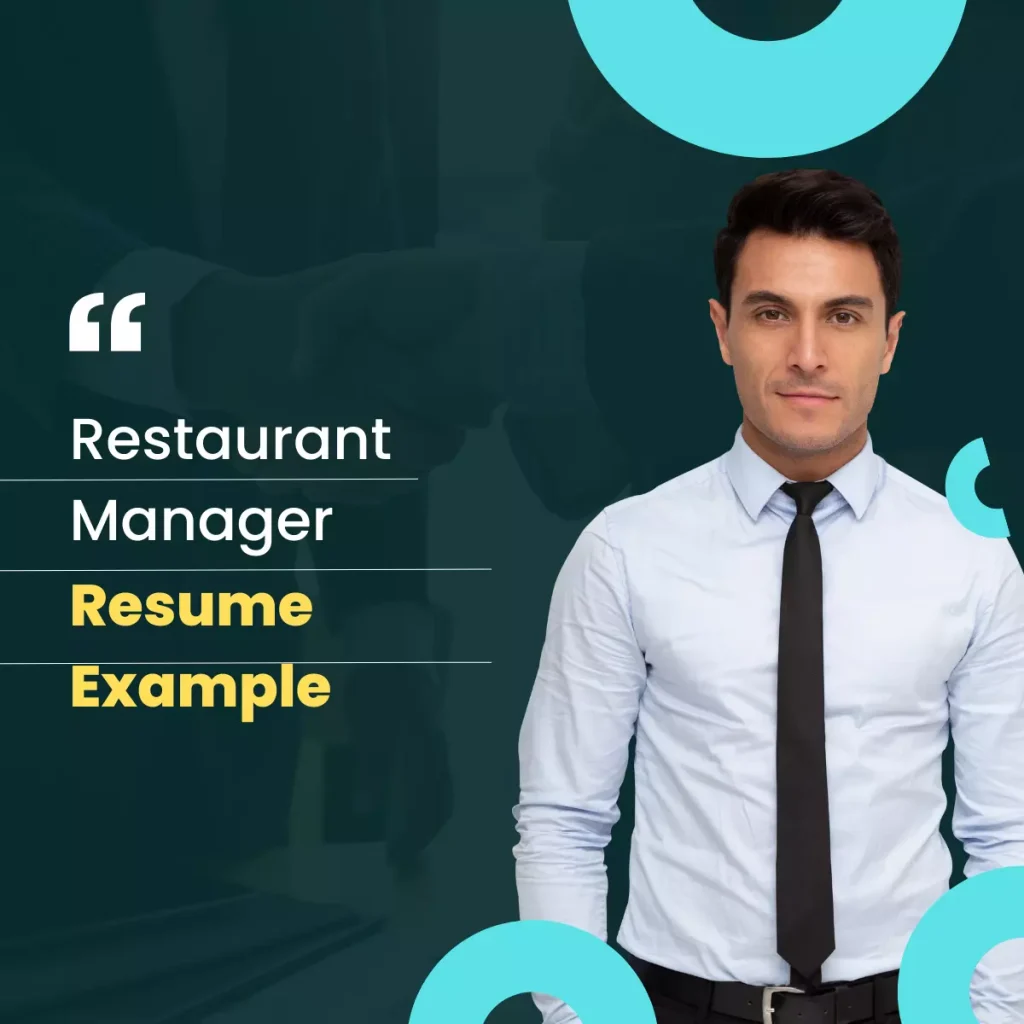
Resume Example – Restaurant Manager Resume: Tips, Examples, and Key Skills

Crafting an Impressive Waitress Resume: Comprehensive Examples and Tips

Pharmacist CV Example: Crafting a Standout Resume for Pharmacy Professionals
Leave a comment cancel reply.
Your email address will not be published. Required fields are marked *
Save my name, email, and website in this browser for the next time I comment.
- Resume Templates
- Resume Examples
- Free Resume Builder
- How to Write a Resume
- Resume Format
- Resume Packs
- Cover Letter Templates
- Cover Letter Examples
- Free Cover Letter Generator
- How To Write a Cover Letter
- CV Templates
- CV Examples
- Free CV Maker
- Resume Help
- Cover Letter Help
- Job Interview
- Career Advice
Combination Resume: Definition, Examples, and Writing Tips
Most resume formats fall into one of two categories. There are functional resumes that emphasize your skills. These are ideal for inexperienced applicants who have developed skills through their education but have less on-the-job experience.
There are also chronological resumes – the standard choice for experienced candidates who prefer to highlight the work they have done, and the positions they have held. Sometimes forgotten, is the third resume type – the combination resume.
What is a Combination Resume?
A combination resume meshes chronological and functional resume formats. It emphasizes your skills, experience, and accomplishments without following the timeline of a chronological resume.
The standard combination resume format opens with a larger header area , featuring a skills summary or qualification section. Afterward, it lists a condensed chronological work history and educational credentials.
Who Should Use a Combination Resume Format?
Many people can benefit from using a combination resume. Those who are seeking a career change or recent graduates are especially likely to find it useful. This is because these folks tend to have:
- At least some work experience
- Hard and soft skills
- Relevant education
At the same time, because they are entering fields that are new to them, they need to find a way to balance the best elements of functional and chronological resume formats . Thus, the combination resume is a perfect option.
That said, a combination resume can work for other professionals too. Martin Yate , an international expert in resume writing and a best-selling author, argues that candidates can get better results with a new resume layout , which includes:
- Performance Summary subhead that explains how you’ve helped past employers achieve their goals. This is where you should use the employer’s phraseology and keywords from the job description as much as possible.
- Professional Skills section, offering an overview of your core competencies, ideally formatted as two or three columns.
By adding the above information at the “front” you target the recruiter with the right message. First, you confirm that you can fulfill the job requirements. Secondly, you explain how you’ll do that through a combination of highlighted hard and soft skills.
Sample Combination Resume (Word Version)
Let’s now move on from theory to practice and check several working combination resume examples.
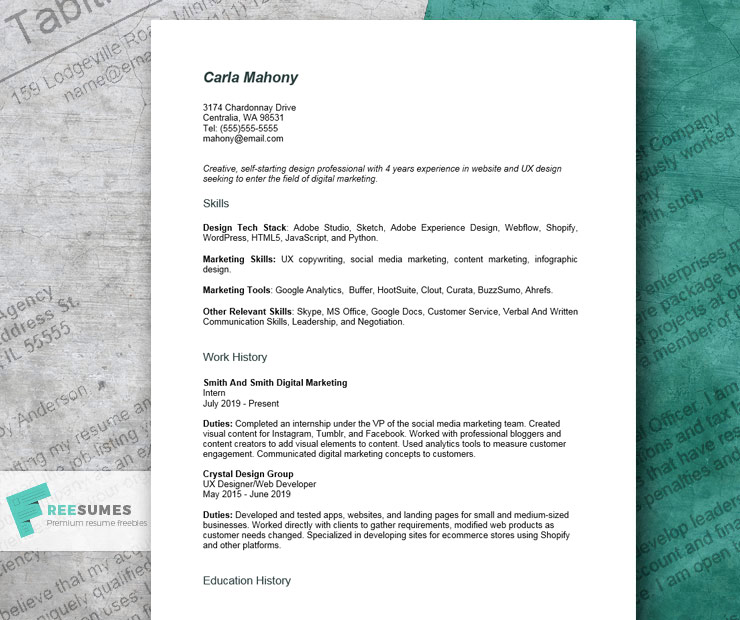
Download resume example (.docx)
Combination Resume Example (Text version)
Creative, self-starting design professional with 4 years of experience in website and UX design seeking to enter the field of digital marketing.
- Design Tech Stack: Adobe Studio, Sketch, Adobe Experience Design, Webflow, Shopify, WordPress, HTML5, JavaScript, and Python.
- Marketing Skills: UX copywriting, social media marketing, content marketing, infographic design.
- Marketing Tools: Google Analytics, Buffer, HootSuite, Clout, Curata, BuzzSumo, Ahrefs.
- Other Relevant Skills: Skype, MS Office, Google Docs, Customer Service, Verbal And Written Communication Skills, Leadership, and Negotiation.
Work History
Smith And Smith Digital Marketing Intern July 2019 – Present
Duties: Completed an internship under the VP of the social media marketing team. Created visual content for Instagram, Tumblr, and Facebook. Worked with professional bloggers and content creators to add visual elements to content. Used analytics tools to measure customer engagement. Communicated digital marketing concepts to customers.
Crystal Design Group UX Designer/Web Developer May 2015 – June 2019
Duties: Developed and tested apps, websites, and landing pages for small and medium-sized businesses. Worked directly with clients to gather requirements, and modified web products as customer needs changed. Specialized in developing sites for ecommerce stores using Shopify and other platforms.
Educational History
University of North Texas July 2012 – May 2016 BA Graphic Communications And Digital Media Minor: Business Management GPA: 3.65
Accomplishments and Awards: Dean’s List, Student Council Representative, Member of Creative Students Association, Recipient of The Graphic Communications Society Gold Standard Plaque, Graphic Design Society of North America scholarship Recipient.
Additional Awards And Experience
ASPCA Volunteer Leader 2016 Boys LaCrosse Coach U1 – U8 Karate Instructor Volunteer Regional Director, Art Across America Initiative for Disadvantaged Youth
Combination Resume IT Example
Chelsea Westacott iOS mobile app developer Objective C & Swift
Product-minded engineer, experienced in developing, testing, and debugging native iOS applications for financial, gaming, and ecommerce companies. Familiar with MVVM & MVC architectures and optimization of iOS memory concurrency to ensure high application performance.
Technical Skills:
- Swift and iOS frameworks (Core Data, Core Animation, Grand Central Dispatch)
- iOS Tools and packages: Xcode IDE, Fastlane, Swift Package Manager, CocoaPods
- Mobile app testing and debugging: Appium, Kobiton
- API programming: RESTful API integrations.
- Agile and RAD software development methodologies
People Skills
- Proven track record of successful cross-functional collaboration
- Experience in mentoring junior software engineers
- High attention to detail in code reviews
- Practical experience with Scrum and feature prioritization
Work Experience
Senior iOS App Developer Santa Fe Dev Studios Dec 2021-present
Collaborate with product team and customers on requirements gathering and clarification for new ecommerce applications. Develop advanced iOS mobile features to support AR shopping, in-app commerce live streams, and visual search. Defined, created, and improved a database of automated test cases, thanks to which the number of app crash incidents in production decreased by 35%.
iOS App Developer Digital Bank April 2019-Nov 2021
Helped ship the MVP of a digital banking app and later supported a feature maturation strategy. Successfully implemented features for KYC, personal finance management, and P2P payments. Improved app load time by 25% through efficient code refactoring and optimized API management, resulting in a better UX and a 20% increase in daily user engagement.
The University of California Sep 2016 – May 2019 BS in Computer Science Minor: Product Management
Professional Certifications
- Apple Certified iOS Developer (ACID), issued July 2019.
- Udacity iOS Developer Nanodegree, completed in Aug 2020

Recommended Combination Resume Templates
For a combination resume, you need a template with ample space in the header area to fit in your summary section. Alternatively, you can opt for a two-column resume. This works better if you’d rather have a longer work experience section and a bullet-point-styled skills section in the side column.
At Freesumes, you’ll find over a hundred absolutely free and fabulous resume templates for all popular formats. Below are our top recommended combination resume templates:
How to Make a Combination Resume Step-By-Step
An effective combination resume accentuates your most marketable skills and competencies in the header and then further contextualizes these in the shorter work and education experience sections.
Ideally, you should aim to allocate one-third of the page towards your resume summary and the remaining two-thirds for other resume sections .
Your resume summary should be clear and concise, tailored to the job for which you are applying. Your work experience and education sections should further elaborate on how you apply the listed skills to perform your duties, drive specific work outcomes, and generate value for your employer. Lastly, emphasize any relevant certifications, training, volunteer, or extracurricular activities that make you stand out among others.
Here are the step-by-step instructions for making a combination resume.
Open with a Compelling Resume Summary Section
Think of this section as a “teaser” for your resume: Advertise your most relevant competencies and some note-worthy achievements. If you’re new to the field or changing careers, you can also add a one-sentence resume objective statement to explain what type of roles you’re after, just like in the first resume sample.
Craft a Banging Skills Section
Start with a resume outline and make a list of relevant skills that you already have. Include a good mix of role-specific competencies, technical skills, and soft skills. Don’t skim on the latter, since 97% of employers consider soft skills just as important or even more important than hard skills.
Next, you’ll want to back up these with your work experience. For example, you may list graphic design as one of your core skills. Later in your resume, you can show that you have used that skill in the real world designing logos for small business owners.
Need some inspiration? Check our lists of recommended skills for a resume:
- Self-management skills
- Critical-thinking skills
- Meta skills
- Organizational skills
- Administrative skills
- Conceptual skills
Focus On Transferable Skills
If you’re a recent graduate or seeking a career change, you probably have some skills that will make you more productive. These are called transferable skills .
Most soft skills fall into this category. However, depending on the job you are pursuing, you may have hard skills that are transferable as well. For example, there are several careers where having advanced MS Excel skills is considered to be a real selling point.
Pro tip : Your combination resume has to emphasize the skills and experience the company needs. That’s why you should use the job listing itself to help you determine which skills and experience should receive the most attention.
Don’t Forget The Extras
A combination resume format allows you to include relevant awards, volunteer work, research , and even hobbies and interests that you may not normally fit in a more standard one-page resume. Don’t hesitate to share some extra interesting facts about yourself if these can help better contextualize your work experience and personality.
That said, your resume shouldn’t look “crowded” as this affects readability. To compactly fit extra details, grab a free Google Docs resume with a two-column design or one of our recommended combination resume templates!
Final Thoughts
Despite not having the best work experience, you can create a resume that allows hiring managers to see you as an excellent fit for the position by combining your work experience, relevant skills, and education.
You can further impress the reader by carefully curating your duties and contextualizing your skills through accomplishments. Although less traditional, combination resume packs a powerful punch!

Elena runs content operations at Freesumes since 2017. She works closely with copywriters, designers, and invited career experts to ensure that all content meets our highest editorial standards. Up to date, she wrote over 200 career-related pieces around resume writing, career advice... more
you might also like

Persuasive Preschool Teacher Resume Example And Tips

Plumber Resume Example and Writing Tips

Massage Therapist Resume Example and Tips

Travel Nurse Resume Example and Tips

Hostess Resume: Example and Actionable Tips
Leave a response cancel reply.
Combination Resume: Definition & Tips
There are three main resume formats that are commonly used today: reverse chronological, functional, and combination. This article will be focused on combination resumes, which are the least commonly used but serve a specific purpose for some job seekers. Read on to discover what a combination resume is, who should consider using the format, and how to write an excellent one.
Combination Resume Definition
A combination or hybrid resume is designed to showcase your work experience and skills together. This format stands out by featuring a skills summary at the beginning, followed by your work experience and additional skills. By blending the key elements of both the chronological and functional resume formats, a combination resume provides a comprehensive overview of your qualifications and achievements.
Other Resume Formats
The reverse chronological resume format is the most widely used, and it focuses primarily on work experience and/or education . It’s the easiest for employers to scan and it allows you to showcase your progression within your field or highlight your educational achievements if you are a recent graduate.
Functional or skill-based resumes focus more on hard and soft skills rather than providing a timeline of your work experience. This can be useful if you work in a creative profession where your skills are more important than your job titles, if you have multiple long gaps in your employment history, or if you are overqualified for a position.
Who Should Use a Combination Resume?
A combination resume is best suited for experienced professionals who have lots of work experience but some gaps in their employment history, those looking to make a career change, or those targeting very niche positions that rely equally heavily on work experience and skills.
Combination resumes are the most difficult to create out of the three main formats, so unless you have a specific reason to use a combination resume, you will likely be better off sticking with a reverse chronological or functional resume.
Students, recent graduates, and those who can demonstrate a clear and consistent progression within their field will likely not benefit from using a combination resume.
Sections To Include on a Combination Resume
If you feel that a combination resume will most effectively showcase your skills and work experience, be sure to include the following sections:
1. Resume Header
As always, begin your resume with a header that contains your full name, your contact information , and your customized LinkedIn URL. You can also include your address (or just your city and state) as well as your website or social media links if applicable.
2. Resume Summary
Next, add a compelling resume summary to catch the potential employer’s attention. Your resume summary should be 2-5 lines of text that effectively sum up your entire resume. Mention your experience, educational background, relevant certifications , skills and abilities, and specific metrics that back up your expertise and demonstrate your successes.
Here’s an example of what a resume summary might look like:
Passionate freelance graphic designer with 7 years of experience, seeking an in-house design position with ABC Design. Studied at XYZ School of Design and taught entry-level courses as a grad student. Professionally created a wide variety of logos, infographics, websites, branding packages, and more for clients spanning multiple industries using the Adobe Creative Suite.
3. Skills Summary
Then add a summary of your most relevant skills, breaking your skills into groups and providing more details. Under each skill subheading, write bullet points that describe your achievements and quantify your successes.
This summary section should only include the skills that are especially pertinent to the job - you can include an additional skills section later that outlines your other skills that are impressive but may be less directly relevant.
So, a skills summary might look like this:
Graphic Design
- Expert proficiency level with all Adobe Creative Suite programs, including Photoshop, Illustrator, and Dreamweaver
- Named XYZ School of Design’s “Designer Most Likely to Succeed” in 2014 and DEF Design’s “Most Promising New Designer” in 2015
- 7 years of experience designing for clients spanning many industries and countries
- Created unique, compelling branding packages for 30+ companies per year
- Developed new client-facing website for DEF Design to streamline onboarding process
- Exceeded all client expectations by presenting cutting edge design packages
Communication
- Coordinated with multiple clients on a weekly basis
- Exceptional written, verbal, and presentation skills
4. Work Experience
Add your work experience to support your skills summary. You can either list your past experience in reverse chronological order or simply include the most relevant positions that you’ve held in the past. Dates of employment and the timeline of your career are less of a focal point in a combination resume than they are with a reverse chronological resume.
For each position, list your job title, the company name and location, and a few bullet points that outline skills you honed and your accomplishments in each position.
5. Education
Next, add your education details. There’s no need to include your high school information if you have already completed college or a graduate degree. When listing your education information, include the name and location of each school, the degree you earned, your area of study or major, and the year you graduated.
If you have space, you can include relevant coursework or academic achievements , but remember that your resume should only be one page if you have less than 10 years of experience and no more than two pages if you have more experience than that. If it comes down to it, you should always include more details about your relevant skills and work experience rather than extra information about your education. Potential employers will generally be more interested in your recent accomplishments.
6. Additional Skills
Finally, you can create an additional skills section to feature your other skills that didn’t make it into your skills summary. You may want to use subsections to list your soft skills and your hard skills.
7. Optional Resume Sections
If you still have room on your resume after including all of the above sections, you may wish to add one or more optional resume sections, such as languages , hobbies and interests , internships , and so forth. Only include these sections if you have something relevant and appropriate to list.
Tips For Writing a Combination Resume
Here are some tips to keep in mind when crafting your combination resume.
Tailor Your Combination Resume to Each Job Application
One of the best ways to boost your chances of scoring an interview is to tailor your resume to each job that you apply for. To do this, read the job posting carefully and identify keywords and phrases that describe the skills and experience that the employer is specifically looking for. Then use these words and phrases in your combination resume, addressing as many as possible of the desired qualifications that apply to you. Always be sure to mention the company and the position by name in your resume summary.
This will help your resume pass automated applicant tracking system ( ATS ) scans, and it will also show the potential employer that you took the time to read the job posting carefully and customize your resume.
Showcase Transferable Skills
If you are making a career change or if you have some experience that prepared you for your target role in a way that may not be obvious, be sure to highlight transferable skills. These are skills and strengths that apply in many (if not all) industries, such as leadership ability, communication skills, and so forth.
Often, soft skills are the most transferable, since they generally aren’t industry-specific to begin with. But, some hard skills may be useful in many positions, such as expertise with commonly used programs like Microsoft Word or Gmail.
You can outline how you will apply these transferable skills in your new role in the bullet points below each of your past positions and/or in your skills summary.
Link Your Skills to Professional Experience and Achievements
Rather than simply listing your job duties and responsibilities under each of your past positions, focus on your achievements in that role. Link each of your most impressive skills to an accomplishment, and quantify it whenever possible with numerical data. For example, you might say that you “created comprehensive brand guidelines for 30+ businesses each year with a 98% client satisfaction rating.” This statement showcases your experience and creative ability, and backs up your claims with hard data.
Key Takeaways
A combination resume can be the best option for those who have a lot of experience but some hard-to-explain gaps in their resume, those making a career change, and those who are applying to positions that rely equally on skills and experience. However, it is the most difficult resume template to create, so only those who truly need to should use a combination resume. To create an effective one, include your resume summary followed by a skills summary and then your professional work history. Be sure to link each of your key skills to accomplishments and tailor your resume to each job that you apply for.
Not sure how to build your combination resume? Consider using Jobseeker ’s professional resume creation tool. It allows you to input all of your details, test out different formats, layouts, and color schemes, and then download your polished resume instantly so you can get started applying to jobs right away!
Get ahead of the competition
Make your job applications stand-out from other candidates.
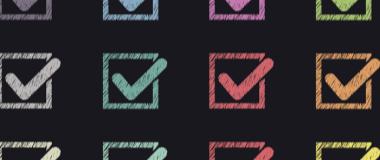
Resume Checklist: How To Write a Winning Resume

How to Include References on Your Resume

How Long Should a Resume Be?
Resumes bot – Resume Writing Service
Combination Resume Format
ResumesBot » Blog » Resume and Cover Letter Tips » Combination Resume Format
Table of Contents
Two of the three most popular resume formats – chronological and functional – have their pros and cons, but when you cannot decide on a clear winner, chances are good that the third most popular choice, combination resumes, are an effective compromise for you. This format balances the best features of the other two by giving equivalent space to both your career skills and your work history.
What Is the Best Definition of a Combination Resume?
A combination resume definition explains how this format brings function and chronology together in just a page or two. It presents your unique skills, abilities and accomplishments and also summarizes your employment history in reverse-chronological order.
What is a combination resume? It is a hybrid resume format that creates a complete picture of you as a career professional. It helps hirers see that you are far more than just a space filler. It offers you the opportunity to highlight your aptitude for the job while satisfying the employers’ curiosity about where you have worked and for whom.
Of course, this method of organizing your career information also includes the basics you would find on any resume. Your contact information, a summary of your career goals, and your academic degrees/professional certifications are all important features that you need to include in the appropriate places.
Combination Resume Templates
You can easily nail the combined resume format by accessing a combination resume sample online. In general, sites that offer the combination resume template free of charge provide the same general format:
- Your contact information
- Brief summary of your career goals/skills
- Relevant skills and accomplishments
- Your experience/job history
- Your academic credentials
Combination Resume Example
Combination resume formats are versatile. They allow you the flexibility to decide what information you wish to include and how to present it.
For example, in a chronological resume, one of the first sections lists every job you have held over the past decade. With your work history in the spotlight, you probably do not want to leave anything out. That would create a gap that would require an explanation during an interview.
In a combination resume, your skills and accomplishments are equally important as your job history, so you can highlight only those jobs that relate to those skills, accomplishments and relevant experiences.
How to List Publications on CV
Jobs that Don’t Involve Customer Service
How to Write a Combination Resume
Even while following the template point for point, you can still make your combination resume unique with a few smart additions. If you want to get an edge on other applicants:
- Use keywords from the job description in your resume.
- Double-check your spelling and grammar.
- Get rid of non-relevant information, such as your marital status or your favorite books.
- Use action verbs whenever possible.
- Add lines between sections to make it easier for employers to skim.
Also, confirm all of the information on your resume is accurate and up-to-date. Make sure to add any recent skills and experience, and eliminate outdated information. Rework your data to apply directly to the job you are seeking. For example, if the job description calls for knowledge of specific software, highlight your corresponding knowledge, if you have it.
Contact Information
This information should appear in the header of your resume. It should include your name, address, phone number, email and the URLs of your professional networks and portfolio, if any.
Skills Summary
Make sure that the skills listed in this section relate directly to the job at hand. If the position is managerial, for example, include those skills that relate to management, coaching, mentoring and supervising others.
Additional Skills
Under this heading, you can add career skills that are related but not necessarily specific to the job opening. For example, you could mention that you have mentored young people through the Big Brothers/Big Sisters program.
Professional Experience
This is the spot where you summarize your job history. It is perfectly fine to omit jobs unrelated to your career field and the job opening itself. Remember, however, to list your most recent position first and then the others in reverse chronological order. List only relevant positions you have held in the past 10 or so years.
Organize your college/trade school history in reverse chronological order. Include the name of the institution, the city and state where it is located, and the degree or certification you earned. If you have been out of college for more than a few years, consider omitting dates from this section.
Merging chronological and functional resume formats into a combination format is a highly effective way to tout your skills and achievements as a career professional. It also highlights your most relevant work experience. As one of the three most commonly used resume types, the combination format is designed for clarity as well as impact. It may just be the right choice for your next job application.
How useful was this post?
Click on a star to rate it!
Average rating 5 / 5. Vote count: 3
No votes so far! Be the first to rate this post.
Add a Comment Cancel reply
Your email address will not be published. Required fields are marked *
Email Address: *
Save my name, email, and website in this browser for the next time I comment.
We use cookies to give you the best possible experience on our website. Read our Terms and Privacy Policy to learn more.
The Best Resume Format: 20+ Examples + How-to Tips
How to format a resume the right way and how to choose the best of the three standard resume formats, depending on your current career circumstances. Plus, examples of well-formatted resumes you can steal.

The term “resume format” might mean different things:
- For some, it’s about the nuts and bolts of the document—things like margins, fonts, overall structure.
- For others, it’s about picking the right type of the three standard resume formats—reverse-chronological, functional (skills-based), or combination (hybrid).
- Then there are those who think of “format” as the visual design and layout of a resume.
Whichever of those aspects of resume formatting you’re curious about, you’ll get all the answers you need here.
In this guide:
- How to format your resume to make it readable and professional.
- Which resume format to choose, based on your current career situation.
- Recent resume formatting trends you should know (and not always follow).
Just came here for the TL;DR version? Here it goes.
Short answer:
- Consistency is the most important aspect of resume formatting. Use a standard font like Arial, Calibri, Helvetica, Georgia, or Garamond. Use 10–12 pt font for the main body and 14–16 pt for headings. Set line spacing for 1–1.15 and margins not below 0.5 inches. For dates, choose one date format and stick to it.
- To save time and effort and make sure your resume looks just right, use an online resume builder. Obviously, I’d love you to take Rezi for a spin because we’re strongly focused on ATS-compliant formats, but if you want alternatives, Wozber, FlowCV, and Teal are also worth a try.
- The reverse-chronological resume format is a safe choice for all jobseekers and the best choice for 9 out of 10 candidates.
- If you’re fresh out of school and have no work history to showcase, still use the reverse-chronological resume, just put your education section above the work experience part.
- The combination format might work if you’re changing careers, but only if you’ve had a lot of professional experience in that previous field.
- The functional resume format is usually too risky. Use at your own peril. The only scenario where it might be okay is if you’re applying for a highly-creative role and your portfolio matters more than your resume.
How to Format a Resume?
- Set margins for 1 inch. If a few lines spill over to the next page, you can make your margins slightly smaller, but not smaller than 0.5 inches.
- If you have less than 5 years of experience, make your resume one-page. Two-page resumes are fine for mid-level to senior-level candidates.
- Use one of the standard, recognizable fonts like Arial, Calibri, Merriweather, Helvetica, Georgia, or Garamond. You can use a different font for headings: a combo of serif and sans-serif fonts often looks better.
- Go for 10–12 pt font for the main body and 14–16 pt for section headings.
- Put essential information in bold but don’t overdo it—use it for things like company names, educational institutions, or certifications.
- Use single or 1.15 line spacing for the main body, and 1.5–2.0 for the space between headings and sections.
- Structure your sections in the following order: Contact Information, Summary, Work Experience, Education, Skills, Additional Sections (Certifications, Courses, Conference Participation, Volunteer Work, and similar).
- Use bullet points to describe your duties and achievements in your work experience section. Use up to 7 bullet points per job—the more recent the position, the more bullets you can shoot for.
- Save your resume as a PDF unless the job ad explicitly asks for a different file format. Name the file FirstName_LastName_Resume_TargetCompany , e.g., John_Doe_Resume_Apple.
Formatting your resume right won’t automatically get you hired. Formatting it wrong, though, will automatically get you rejected.
It’s the bare minimum you need to take care of in your job application. So yeah, don’t mess it up.
These essentials make sure your resume isn’t just professional, but also easy to skim and visually appealing.
Set proper margins
Margins frame your resume, giving it a clean, organized look. Aim for one-inch margins all around. If you’re tight on space, you can squeeze them down a bit—just not below 0.5 inches to avoid a cramped look.
Use respectable fonts
Your choice of font matters a lot. Stick to clear, professional fonts like Arial, Calibri, Merriweather or Times New Roman. Keep the main text between 10 and 12 points, bumping up headings a bit to make them pop. The aim is clarity, ensuring anyone can easily read your resume.
Get your line spacing right
Good line spacing keeps your resume from looking like a wall of text. Use single spacing for your content, with a bit more space between sections (1.5 to 2.0) to break things up visually.
Use clear, descriptive headings
Headings guide readers through your resume, so they need to stand out. Whether you bold them or use a different font, keep it consistent. This helps employers quickly find what they’re looking for.
Put the sections in the right order
How you organize your resume sections can make a big difference. Kick off with your contact info and a punchy summary or objective. After that, what comes next depends on what you want to highlight. Usually, you’ll lead with your work experience, followed by education, skills, and any extra goodies like certifications or awards.
Use bullet points strategically
Avoid using paragraphs to describe previous experience. Bullet points are your best friend for listing achievements and responsibilities. Start each one with a dynamic action verb and, whenever you can, quantify your successes. This format is not just reader-friendly, it also shines a spotlight on your contributions.
Save your resume as a PDF
When saving your resume, PDF is usually your safest bet to keep the formatting consistent across different devices. Name your resume file clearly with your name and the word “resume,” like, John_Doe_Resume.pdf .
For brownie points, you can add the name of the company you’re applying to: Michael_Tomaszewski_Resume_Rezi.pdf (to be frank, I never got to send one).
Understanding these formatting basics sets a solid foundation for your resume, making it look good and read well.
But that’s the easy part. Here’s where things get a little more complicated (or do they?).
Which of the Three Resume Formats is the Best?
- The three standard types of resume formats are: reverse-chronological (the most common one, focused on your work history), functional, AKA skills-based (focused on your skills), and combination (highlighting skills while tying them to professional experience).
- Reverse-chronological resume format is the best choice for most candidates, no matter their industry or seniority level.
- Combination resume format can work well for senior professionals with stellar achievements or for career-changers with extensive experience in their previous field.
- Functional resume format is generally risky: most recruiters don’t like it, and it might not pass some ATS scans. You can get away with it when applying for creative roles, where your portfolio matters more than linear work experience.
I’ll go into details right below. But first, consult this handy flowchart.
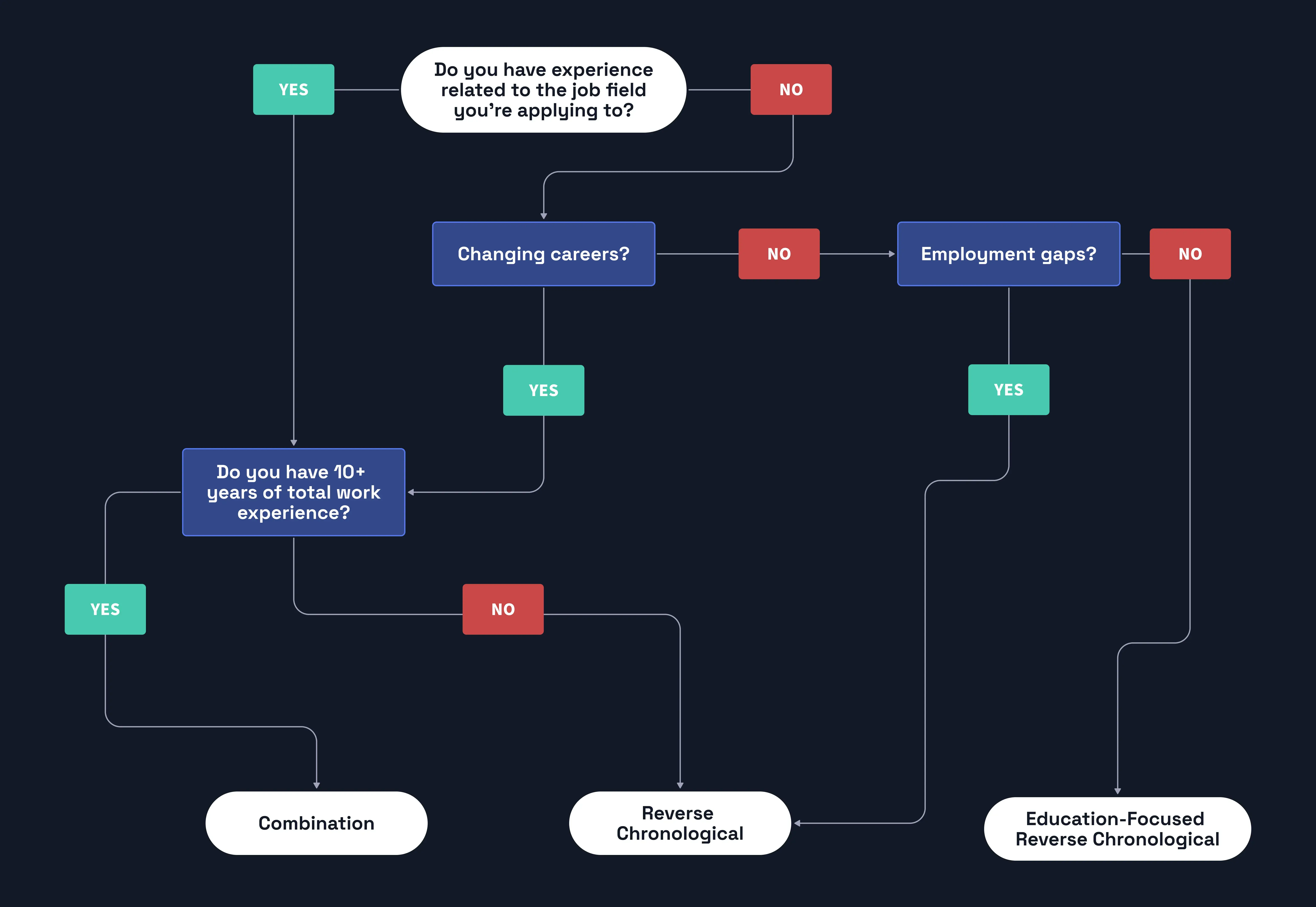
Below, I’ll break down the three main types to help you pick the best one for your current situation and career goals.
Reverse-chronological resume format
This is the go-to format for most jobseekers. Its main focus is in the work experience section, with jobs you’ve held listed in reverse-chronological order (starting with the current or most recent one, then working your way back in time).
This is the standard order of sections on a reverse-chronological resume:
- Contact Information
- Resume Summary or Resume Objective
- Work Experience
- Additional sections (Publications, Courses, Certificates , Volunteer Work , Hobbies and Interests, and similar)
And here’s what a good reverse-chronological resume looks like.
Reverse-chronological resume sample

Pros: it’s a recruiter- and ATS-friendly resume , highlighting your career progression and best achievements. It focuses exactly on what matters the most to potential employers.
Cons: if you’ve had plenty of success over many years of your professional career, some of the best bits might get lost between the cracks of a reverse-chronological resume.
This format is a no-brainer when you’ve had a straightforward career in the same field.
That said, the reverse-chronological resume will work well even for career-changers, people with career gaps, or recent grads with little to no professional experience.
Here’s why:
- Career changers: write an effective reverse-chronological resume by expressing your desire for a career switch in the resume summary, then, focus on experience and skills that are transferable to the new industry.
- Employment gaps: a 2014 study has shown that career gaps are far less significant to hiring decision-makers than you’d fear. As long as the gap has been followed by a period of continuous employment, it’s unlikely to bother your potential employer. The same goes for any gap shorter than 9 months. It shouldn’t even be called a “gap” in that case, you were just out of work for a while. Of course, you still need to explain the break, but something as straightforward as “Job Seeking” or “Break for Personal Reasons” will do the trick.
- No relevant work history: still fresh out of school with no work experience? Put your “Education” section above your “Work Experience.” In the education section, elaborate on relevant coursework or extracurricular activities . As for the work experience, list anything that might count, even that part-time cafeteria job or volunteer work.
Note : more recent, post-pandemic studies suggest that Americans do display slightly negative sentiment towards those who were unemployed during the pandemic. That said, those surveys were run on general population, not hiring professionals, so take the results with a grain of salt.
Functional (skills-based) resume format
Here, you focus on your skills rather than when you worked where.
It’s commonly advertised as *the* resume format for candidates with gaps in employment or who are switching careers and want to highlight transferable skills.
The twist is that, technically, you don’t even have to put in the dates next to your jobs. And that might sound really tempting to those of you who aren’t too confident about your career progression so far.
But it just doesn’t work like that.
You’ll be much better off honestly addressing any irregularities in work history on your resume than trying to conceal those. A functional resume immediately raises questions.
Honestly, any time I had to write a sample functional resume to show that it MIGHT work, I always ended up creating something closer to a combination resume (more on that in a moment).
This is the standard order of sections on a functional resume:
- Resume Objective
- Skills Summary
- Additional sections
Here’s what it looks like in practice.
Functional resume sample

Pros: it lets you play up your strengths and downplay less relevant positions. Can be a good choice for creative or artistic positions or when applying to small businesses.
Cons: recruiters aren’t fans because it can seem like you’re hiding something. It’s not great for dealing with ATS scans. It conceals what hiring decision-makers are interested in the most—your career progression.
If you’re dead set on using the functional resume format, by this point, I’ve probably run out of options to convince you otherwise.
My final piece of advice: provide concrete examples that prove the skills you’re listing. And if you have an online portfolio, by all means include a link in the contact information section.
Combination (hybrid) resume format
Also called a chrono-functional resume. A mix of both worlds, this format showcases your skills upfront, followed by a reverse-chronological work history. It’s ideal for highly experienced senior candidates or career-changers who’ve had long stints of employment in their “previous” careers.
- Extensive Skills Summary
Combination resume sample
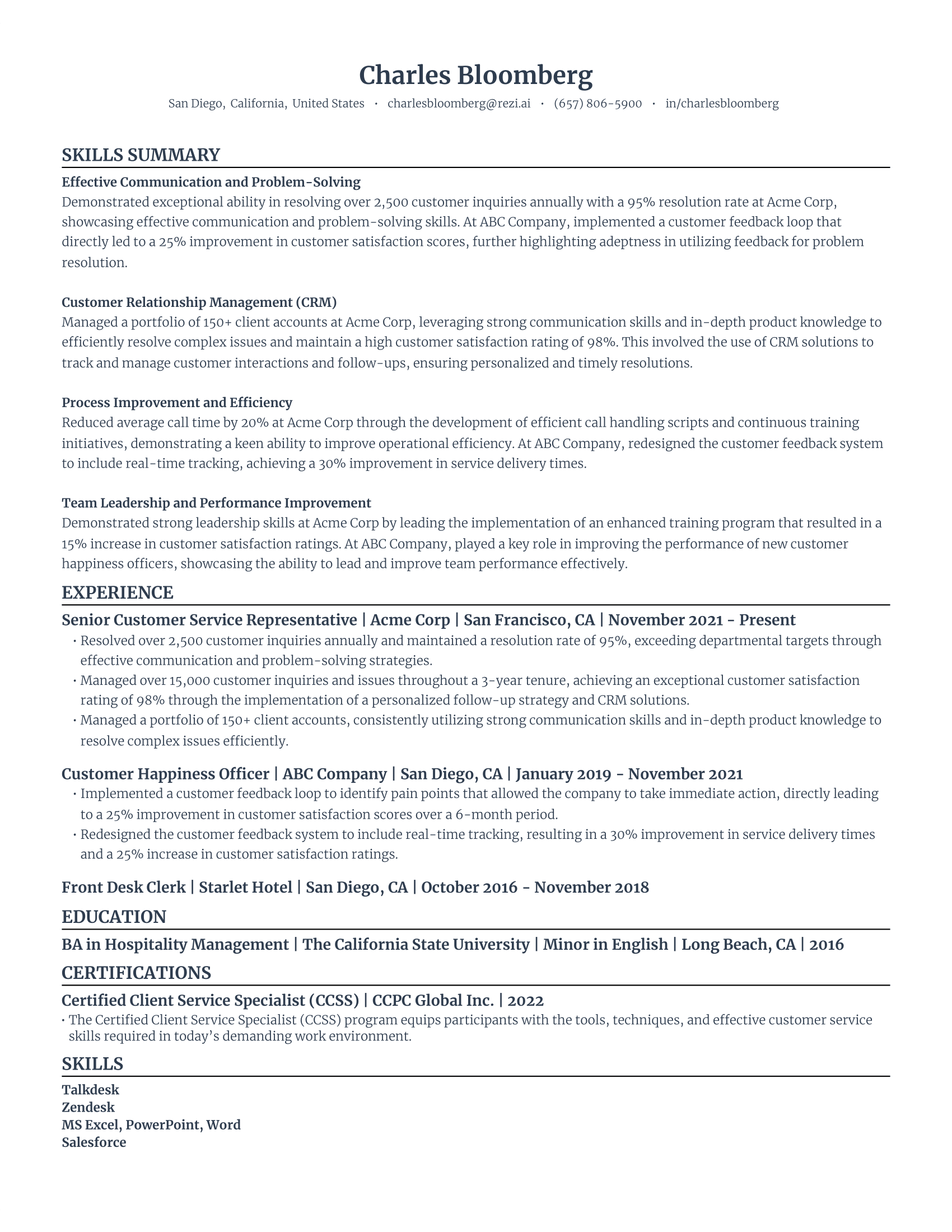
Pros: highlights your most important skills and achievements up top. The magic sauce is tying a skill you mention to concrete evidence from your work history.
Cons: it’s fairly difficult to write it well. The whole point is compiling the highlights from your career in the skills summary at the top, but you don’t want to repeat all that information all over again in the work experience section.
A great example of someone who benefited from a combination resume comes from my individual client from a few years back, we’ll call him Jose.
Jose had over a dozen jobs throughout his 20-year career. He wasn’t much of a job hopper, more like a jack of all trades, taking a part-time gig here and there or holding two jobs simultaneously at times.
He spent most of his life as a goalkeeper coach for a soccer club in Florida. Jose also handled some promotional activities for the club, was responsible for fundraising, and worked as a sales rep for a niche goalkeeper gear manufacturer. He was looking for a job in sales. And—
As we started talking, I realized he was an amazing salesperson!
For instance, he single-handedly closed a sponsorship deal with the then Real Madrid’s first-choice goalkeeper (to those of you in the US—trust me, that’s a huge name in Europe) despite competing with the Nikes and Adidases of this world, and other companies he wouldn’t have been able to outbid. He also did spectacularly well managing sales initiatives for the soccer club.
And yet, if two of his most recent job positions had just read “Head Goalkeeper Coach” and “Goalkeeper Coach,” all of those other relevant achievements would have gotten buried. And recruiters won’t dig for information they don’t have readily available at first glance.
Long story short, we wrote a combination resume for Jose and quickly landed him his dream sales gig. If your current situation sounds even a bit similar, this might be your cue!
CV format vs. resume format
Just a quick note here. If you’re looking for a job in academia, none of the above holds true. You’ll need to follow a CV format—and it’s an entirely different document.
A CV (Curriculum Vitae) is not just a “fancy” resume. It’s way more detailed and used primarily in higher education teaching and research positions, covering your entire career.
How to choose the best resume format for you?
Depending on your experience level:.
- Entry-level with no experience: lean towards a modified reverse-chronological resume with the education section above the work experience.
- Mid-level: use the reverse-chronological format, which showcases a solid work history and upward career trajectory.
- Senior-level: go for a combination format as it allows you to display a rich mix of skills and impactful career milestones.
- Career-changers: the combination format is a good bet, letting you emphasize relevant skills over past job titles. You can also use a reverse-chronological resume, but provide some context for your desire to change careers in the resume summary or resume objective.
Depending on other factors:
- Linear work history: when you have a solid, consistent work history in the same field, use the reverse-chronological resume format. If your work history is varied with gaps or changes in career paths, a combination resume format might be better.
- Your industry: creative fields are more open to unique formats and designs. For more traditional fields, stick to the basics of standard resume formatting and, ideally, use the reverse-chronological resume.
- The role’s requirements: no matter the exact structure you end up using in your resume, always tailor any resume format to highlight the skills and experience that the role requires.
Here’s what you need to know about resume formatting and resume formats:
- Make your resume presentable. Treat it as any other formal document. Use an elegant font, single line spacing, 1-inch margins, and clear, visually-distinct headings.
- Always include the following sections: contact information, summary or objective, work experience, education, and skills.
- It’s best practice to throw in additional sections that back your expertise up: certifications, conferences, publications, volunteer work, projects, and similar.
- There are three standard resume formats: reverse-chronological, functional, and combination.
- The reverse-chronological resume is the best pick for a majority of candidates.
- Senior candidates or career-changers with a rich history of employment can benefit from using the combination resume format.
- Functional resumes are a less-than-perfect choice. They’re not exactly ATS-friendly, and they conceal some of the most important information.
Thanks a ton for reading and, as always, keeping my fingers crossed for your job hunt! Got any questions unanswered? Check out the FAQs below or hit me up via a DM on LinkedIn, always happy to talk careers!
Should my resume be one page?
For most early-career professionals, keeping your resume to one page is ideal. It forces you to highlight your most relevant experiences and skills. However, if you’re a mid- to senior-level professional with extensive experience relevant to the job you’re applying for, it’s acceptable to extend to two pages. The key is relevance and value—every section should add something meaningful.
How do I create an outline for my resume?
Start by listing the essential sections: Contact Information, Summary or Objective, Work Experience, Education, Skills, and any other relevant sections like Certifications or Projects. Next, under each category, bullet point the items you plan to include, focusing on achievements and skills. Adjust the order based on the resume format you choose and what you want to emphasize most.
What’s the best resume format for college students?
College students often benefit from a modified reverse-chronological format with education placed above work experience. It allows you to highlight your academic projects, and extracurricular activities, especially if you lack formal work experience. However, if you’ve had significant internships or relevant work, a traditional reverse-chronological format that showcases this experience can also work well.
Can I include a picture on my resume?
Generally, it’s best to avoid including a picture on your resume, especially for jobs in the US and UK, where it can actually work against you due to anti-discrimination laws. However, there are exceptions based on industry (like acting) or geographic location (some countries outside the US expect a photo). Always research the norms for your specific situation.
What’s the best resume format for ATS scans?
A reverse-chronological format is the safest bet for ATS (Applicant Tracking Systems) because it’s straightforward and easy for the software to parse. Regardless of format, ensure your resume includes relevant keywords from the job description, uses standard headings (like “Work Experience”), and avoids overly complex layouts or elements that could confuse the ATS.
What should I always include on a resume ?
Always include your contact information, a summary or objective (tailored to the job), your work experience (with achievements and quantifiable results), your education, and relevant skills. Depending on the job, you might also include sections for certifications, languages, volunteer work, or projects. Remember, customization based on the job you’re applying for is key.

Michael Tomaszewski
Michael Tomaszewski, CPRW, is a resume and career advice expert with 7+ years of experience in the hiring industry. He has helped millions of readers and dozens of one-on-one clients create resumes and cover letters that *finally* do their talents and accomplishments justice.

COMMENTS
Relevant/key skills: The first half of the main show in a combination resume, this is where you list your key skills that are relevant to the role you're applying for. See below for a few different possible approaches to this section. Work history: The second act in a combination resume is a list of your past roles, with responsibilities and ...
Combination Resume Skills Summary Example. SEO, Content Writing, Growth Hacking: Started personal blog for reviewing electronics and latest tech gadgets. Grew email list from 0 to 500+. Ranked in top 5 Google searches for "best dash cameras for Uber", and "best front and rear dash cams".
Sections in the combination resume format usually follow this order: 1. Name and contact information. Regardless of format, your resume should begin with your name and contact information so employers can easily get in touch. Ensure that you are using recent and accurate information, including your current phone number and email address.
Combination resume made with our builder. See 20+ resume templates here. Now, let's break down how to make the most of each of the combination resume format sections. 1. Contact information. Yup, the basics first. If the recruiters are interested in interviewing you, they need to know how to reach you.
4. 5. Draft a compelling professional summary. A summary statement is your first chance to sum up your most important qualifications and previous accomplishments. View it as the elevator pitch of your combination resume, and present your most relevant experience and skills to show employers why you're the best fit for the job.
Combination resume template. To help speed up the resume writing process, here's a combination resume template that you can easily copy-and-paste into Microsoft Word and fill in with your own information: 1. Resume Heading. FIRST AND LAST NAME. Email: [email protected] | Phone: 908 775 555 | Address: 122 Samuel Johns Road, NY 17101 ...
If you're writing a career change resume and still opt for a combination resume, think of transferable skills you can weave in. Examples of traits that can transfer from one job to another are communication skills, problem-solving, adaptability, and teamwork. 5. Expand on Your Work History.
A professional-looking header sets the tone for the rest of the document. Start your combination resume with a professional header. 2. Professional summary. This is where you craft your elevator pitch. The goal is to summarize your career journey and highlight skills that transfer well to the new role.
5. Education. Nowadays, there are many combination resume templates provided by online resume builders, such as CakeResume, or downloadable hybrid resume templates and edit them with word processing software, like MS Word and Google Docs. The education section can also help to highlight your skills in a combination resume.
The Structure of a Combination Resume Format. 1. Basic Information. Obviously your application needs to include your basic info. Be sure to put your name and contact information, including phone number and email, at the top in your resume heading. Some applicants also like to include their personal website (if it looks professional) or a ...
The main parts of a Combination Resume include the following in this order: Contact details. Qualifications summary with descriptions. General skills section. Work experience with descriptions. Education. Each of these areas is considered vital to a combination resume format. Learning how to write a qualifications summary for a combination ...
What is a hybrid/combination resume format? Most resumes consist of the same essential sections; the term resume format refers to how those sections are organized!. A hybrid resume, also called a combination resume, combines the best parts of the chronological and functional resume formats.. This type of resume leads hiring managers directly to your abilities and achievements by putting the ...
A combination resume can be a good option if you want a resume that emphasizes your skills and is formatted for. automatic tracking system (ATS) scanning. You may want to emphasize your skills on your resume if the position you want doesn't perfectly align with the job titles you've held. For example, you may consider creating a combination ...
The combination resume incorporates the best details from both the chronological and functional resume formats. It typically opens with a description of your skills and qualifications and is followed by a concise reverse-chronological work history. A combination resume offers two primary advantages: It allows you to catch a potential employer ...
Why Use a Hybrid Resume. While the combination resume is not as common as a chronological resume, it is gaining in popularity. In fact, as the team of FlexJobs' Career Experts point out, "Hybrid resumes have really become the standard resume in a lot of ways. They combine the best elements of chronological and functional resumes .".
Combination resumes are application documents that you can submit to an employer when you're applying for an open position. This type of resume format emphasizes both skills and accomplishments, along with recent work history. It often uses elements of the other two commonly used resume formats, including:
The combination resume format is a versatile tool that allows you to strategically showcase both your skills and work experience. By integrating elements of both the chronological and functional formats, you create a well-rounded resume that captures the attention of recruiters and hiring managers. Equipped with the examples and tips provided ...
A combination resume meshes chronological and functional resume formats. It emphasizes your skills, experience, and accomplishments without following the timeline of a chronological resume. The standard combination resume format opens with a larger header area, featuring a skills summary or qualification section.
Combination Resume Definition. A combination or hybrid resume is designed to showcase your work experience and skills together. This format stands out by featuring a skills summary at the beginning, followed by your work experience and additional skills. By blending the key elements of both the chronological and functional resume formats, a ...
The combination format is an excellent choice for those looking to return to work after a break. Its focus on relevant skills and professional experience will show off your credentials, even if you have been out of the workforce for years. Applicants who are making a career change.
2. Summary Statement/Objective Statement. A two- to three-sentence paragraph near the top of your resume. The brief statement acts as your professional "elevator pitch" -- you'll contextualize your previous accomplishments and training based on the needs of the new job for which you're applying. 3.
Combination Resume Templates. You can easily nail the combined resume format by accessing a combination resume sample online. In general, sites that offer the combination resume template free of charge provide the same general format: Your contact information. Brief summary of your career goals/skills. Relevant skills and accomplishments.
The combination resume, also referred to as a hybrid resume, is essentially a combination of the chronological and the functional resume formats. It showcases both your top skills and work history. A combination resume is very similar to a chronological resume, but places the skills section ahead of the work history section. Combination Resume Vs.
The term "resume format" might mean different things: For some, it's about the nuts and bolts of the document—things like margins, fonts, overall structure. For others, it's about picking the right type of the three standard resume formats—reverse-chronological, functional (skills-based), or combination (hybrid).